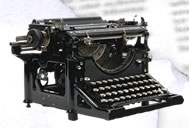It was not beyond the editors of
The Stars and Stripes to indulge in ethnic stereotyping from time to time and, no doubt, they exercised that privilege here as well, however the performance of the American Indian soldier got high marks for a number of valued skills from many Allied officers on the Western Front. It was not simply their ability to shoot well which invited these compliments, but also their instincts while patrolling No-Man's Land in the dark in addition to a common sense of bravery shared by all. The article is rich with a number of factoids that the Western Front reader will no doubt enjoy; among them, mention is made of German women serving in combat.
Read some magazine articles about one of the great failed inventions of the Twentieth Century: the Soviet Union.
This article listed the skills required to survive as a
sniper in W.W. I France:
"One extremely important rule was that he should swab the muzzle of his rifle after every shot, to make sure that no moisture had collected there. One tiny drop of water would, upon the rifle's discharge, send up a puff of steam that would reveal him to his carefully watching enemies."
To see a diagram of the American W.W. I sniper rifle, click here.
The Springfield 1903 Rifles
Written by Major E. Penberthy, former Commandant of the British Third Army
Sniping School, this is an account of the training and organization of
snipers as they functioned within the British Army at the time of the Great War.
"In the early days of the war, when reports of German 'sniping' began to be published, it was commonly considered a 'dirty' method of fighting and as not 'playing the game'."
The attached remembrance of sniping on the Western Front was written by Major H. Hesketh-Pritchard, D.S.O, M.C. (author of
Sniping in France 1914-18) and recalls the development and changes of sharp-shooting on both sides during the war. Pritchard broke down the scouting and sniper involvement on the Western Front into four phases:
Phase I (1914 - 1915): German snipers weigh heavily on Allied soldiers (Clear German advantage)
Phase II (1915 - 1916): British sniping organized (Advantage even)
Phase III (1916 - 1918): British sniper program takes off (Slight British Advantage)
Phase IV (1918 through to the Armistice): Allied Offensive takes effect (Snipers began scouting)
As if simply having to be mindful of wind velocity and camouflage was not enough to occupy the thoughts of your average
World War I German sniper, some were burdened to a further degree by having to affix this half-inch steel sniper mask to their faces...
By enlarge, this article is a mildly technical piece that compares the
German sniper scopes used during W.W. I to those of the British; happily, the amusing part of this essay is contained in the opening paragraph in which a British Tommy returning from the front, is quoted as exclaiming:
"German snipers are better shots than the English because their rifles have telescopic sights that are illuminated at night."
Attached is a remembrance that was written by a Canadian infantryman who participated in the capture of a
German sniper in Flanders:
"We wasted no time on the return journey but hustled "Fritz" along at a brisk pace...Like most of his breed there was a wide 'yellow streak' in this baby-killer and he cried 'Kamerad' instantly. By the time the lieutenant had secured his prisoner's rifle our barrage was falling and, under its protection, he began his march back with the prisoner, and met us before he had gone twenty-five yards...The prisoner expected to be killed at once and begged piteously for his life, saying 'he had a wife and three children.' One of the men replied that if he had his way he would make it a 'widow and three orphans.'"
Two and a half months into the war, a devoted reader of THE SPECTATOR (and we are among them) responded to an earlier article concerning partisan sniping activity in occupied France and Belgium, wrote to the editors to point out that the Hague Convention (precursor to the Geneva Convention) condemned the practice of summary sniper executions. Mention is made of the fact that the occupying German forces
disregarded the law.
